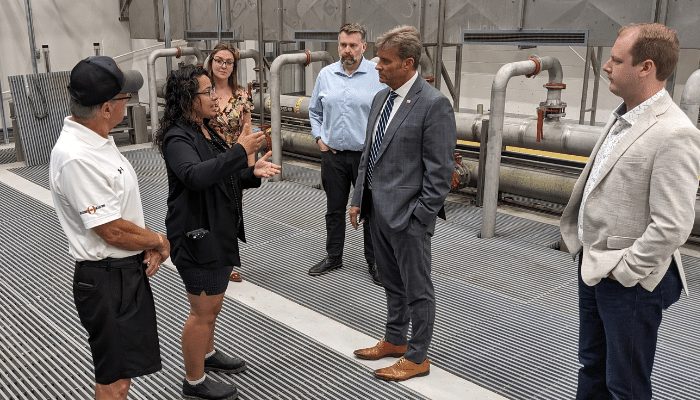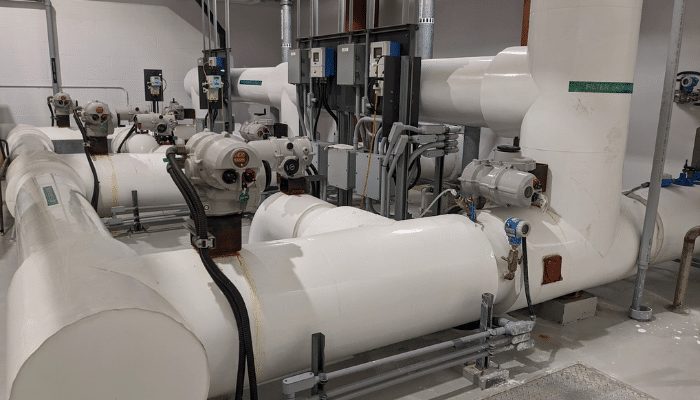The City of Selkirk’s water treatment plant is now heated and cooled with a geothermal system, and it joins the wastewater treatment plant as the second utility to operate without fossil fuels.
“We’re working our way towards being the greenest utility we can be,” said CAO Duane Nicol.
“From a GHG perspective, the water treatment plant was the second largest point source of emissions in the city, with the old wastewater treatment plant being the largest contributor. The new wastewater plant is fossil fuel free in its operations and now, with geothermal heating and cooling in the entire building, the water treatment plant is as well.”
One half of the building – the original side, built in 1961 – was converted to the geothermal system first and the second half was completed this year.
“In 2019 we replaced about half of the outdated heating and cooling systems in the water treatment plant with an innovative geothermal system that uses the city’s existing wells rather than having to dig new ones,” Nicol said.
“The system was designed for expansion and so this year, we replaced the remaining systems making the entire plant fossil-fuel free for regular operations.”
Nicol says using water from existing wells makes the system a great example of asset management and fits in perfectly with the city’s greenhouse gas (GHG) emission reduction plan and the community strategic plan.
Completing the transformation to geothermal also shows the city’s commitment to its Greenhouse Gas Accountability Bylaw, passed in 2021.
Council had a bold vision with the bylaw that mandates the tracking and reporting of Selkirk’s corporate and community GHG emissions using internationally recognized standards. It sets new GHG reduction targets – net zero by 2030 and zero by 2045 – which is consistent with the global effort to keep the climate increase to just 1.5 degrees or less and it establishes a financial framework that clearly and transparently ensures the city can actually meet the targets it has set.
Both water plants accounted for 30 per cent of the city’s total corporate emissions prior to converting to geo thermal.
Prior to 2019 the Selkirk Water Treatment plant accounted for 15 per cent of the city’s corporate emissions on average. In 2018, the last full year prior to the partial conversion, the plant emitted 175 tonnes of CO2e. By comparison, in 2020, the first full year following the conversion of half the plant to geothermal, it produced just 74.7 tonnes. That number will continue to drop with the entire plant operating on the geothermal system.

Prior to using geothermal in the water treatment plant and prior to the new wastewater treatment plant opening, the two buildings accounted for about 30 per cent of the city’s total corporate emissions.
Manitoba Minister of Environment and Climate Kevin Klein visited Selkirk this month to tour several of the city’s environmental upgrades, including the wastewater treatment plant, and he learned about how it and the water treatment plant are now fossil free in their operations.
The geothermal system is innovative, and even more cost efficient, because it uses city wells that were already in use – the city did not have to drill new wells, which is one of the biggest expenses when moving to geothermal.
“You have to upkeep the wells, and we’re already doing that, so that’s the innovation, we didn’t have to drill wells for this, we’re just taking heat off of the raw water that’s coming into the plant anyway,” Nicol said.
Director of Operations Dan McDermid said the geothermal system reduces condensation in the plant, which helps in a couple of ways.
“Inside the water plant is a very moist environment, which sometimes isn’t a good thing when you’re dealing with pumps and fixtures inside a building, so you want to control that moisture,” McDermid said.
“The removal of moisture out of the air reduces the potential for mold production and reduces corrosion, so it’s a lot easier on the equipment.”
Built with future needs in mind
The system has enough capacity that it can serve as a regional geothermal system and could be used to heat and cool new builds like the future multi-purpose recreation building, but also older buildings like apartment blocks in the area that may need new systems.
“We’re making significant progress in achieving our reduction targets and we’re doing it in a cost-effective way, because we’re targeting equipment that is set to be replaced anyway, and we’re replacing it with better,” Nicol said.
In the case of the water treatment plant, the equipment on the newer side of the building wasn’t in need of replacing, but the old boiler system remains and will be used as backup and for the 24-hour shutdown conducted each year for plant maintenance.









